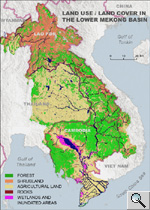14.2 ECOLOGICAL ASPECTS OF AGRICULTURE AND IRRIGATION
Importance
of floodplains for agriculture / The
flood-pulse cycle and silt deposition
/ Rice
farming "natural"
deep water vs intense harvest /
Rice
farming and aquaculture
To understand the nature and scope of this influence, it is important to consider:
• Different types of agriculture occurring within the basin;
• Importance of floodplains for agriculture;
• The flood-pulse cycle and silt deposition;
• Rice farming: 'natural' deep-water rice versus intensive cultivation; and
• The relationship between rice farming and aquaculture.
Agriculture takes place in upland areas
of large and small tributaries, and in lowland areas, mainly on the floodplain
of the Mekong River and its major tributaries.
Upland Agriculture and Irrigation
Swidden cultivation (slash and burn). Swidden agriculture is practiced
in many areas – this type of agriculture has a long history and is intensifying.
Swidden agriculture is undertaken primarily in
highland areas, often by minority groups, and involves clearing of land
on a rotational basis.
Other differences. Upland agriculture activities vary considerably
among areas often in accordance with soil and topographic conditions;
differences include:
• Areas that are used for field crops usually have rich deep soils;
• Areas have that well developed markets for fruit tree crops often have indifferent soils;
• Areas that have industrial tree crops often are chosen for both site and commercial reasons.
 People
in upland areas in general have limited experience with irrigation and
production of commercial crops. However, cropping patterns are changing
in relation to demand for food in urban areas – this has an effect
on water use and timing of water demand.
People
in upland areas in general have limited experience with irrigation and
production of commercial crops. However, cropping patterns are changing
in relation to demand for food in urban areas – this has an effect
on water use and timing of water demand.
Issues. Shifting agriculture is practiced in some areas with serious
erosion and offsite effects. Most upland agricultural lands use rain-fed
agriculture. Irrigation in uplands is currently limited and improper water
use has potential to affect downstream water quantity and quality. Some
areas use pumped irrigation in sloping areas (water from rivers, lakes,
reservoirs or groundwater).
Limitations on irrigation use include:
• Limited experience with upland irrigation;
• Limited experience with upland commercial crops;
• Limited international technology adapted to tropical conditions; and
• Limited knowledge of modern water reservoir storage systems;
Highland agricultural practices have led
to erosion and other negative effects. In general, poor practices are
used in upland areas for limiting floods, erosion, and pollutant runoff.
Poorly developed links between market and production are a major impediment
to improving agricultural production and practices.
Water use efficiency issues relate to water allocation in the dry low-river
season and from underground aquifers. Improvement to water use efficiency
must include water delivery and storage systems, land use practices (especially
those that might lead to erosion) and optimal input for maximum sustainable
outputs. High water use crops such as coffee is placing stress on groundwater
supplies in cross-border areas.
Lowland Agriculture and Irrigation
Most crop production in the Mekong River basin takes place in lowland
areas, primarily in the fertile floodplains of the Mekong River and its
major tributaries.
Importance
of Floodplains for Agriculture--
Floodplain importance. Lowland agriculture is dominated by rice production
in river floodplain areas. The floodplains provide large tracts of relatively
flat, nutrient-rich land. Large areas are being cultivated for production
of rice and other crops in the Mekong River delta in Viet Nam and upstream
along the main river and lower reaches of most tributaries. Significant
crop production occurs in the major sub-basins including the Tonle Sap
River in Cambodia, the Xe Bangfai River in Lao PDR, and the Mun River
in Thailand, and is important for local economies.
The Mekong River is believed to have potential to irrigate several million
ha of agricultural land. Full realization of this potential will undoubtedly
increase existing competition for resources, such as use of water for
intensive rice production versus fish production. Water demand is greater
in dry season when the river is low.
Major agriculture issues
General problems faced by agriculture in lowland areas include:
• Salinity intrusion from the sea affecting agriculture and biodiversity, particularly in Viet Nam;
• Acid sulphate soils impacting on agriculture and biodiversity in Cambodia and Viet Nam; and
• Soil and water contamination from inappropriate use of manufactured chemicals – all countries.
Irrigation systems include major head works that control and divert water from the river source, primary canals that carry the water to a network of secondary/tertiary canals, and eventually to the farm users. Types and amounts of irrigation vary accord to the different agricultural production and irrigation uses in different ecological zones.
